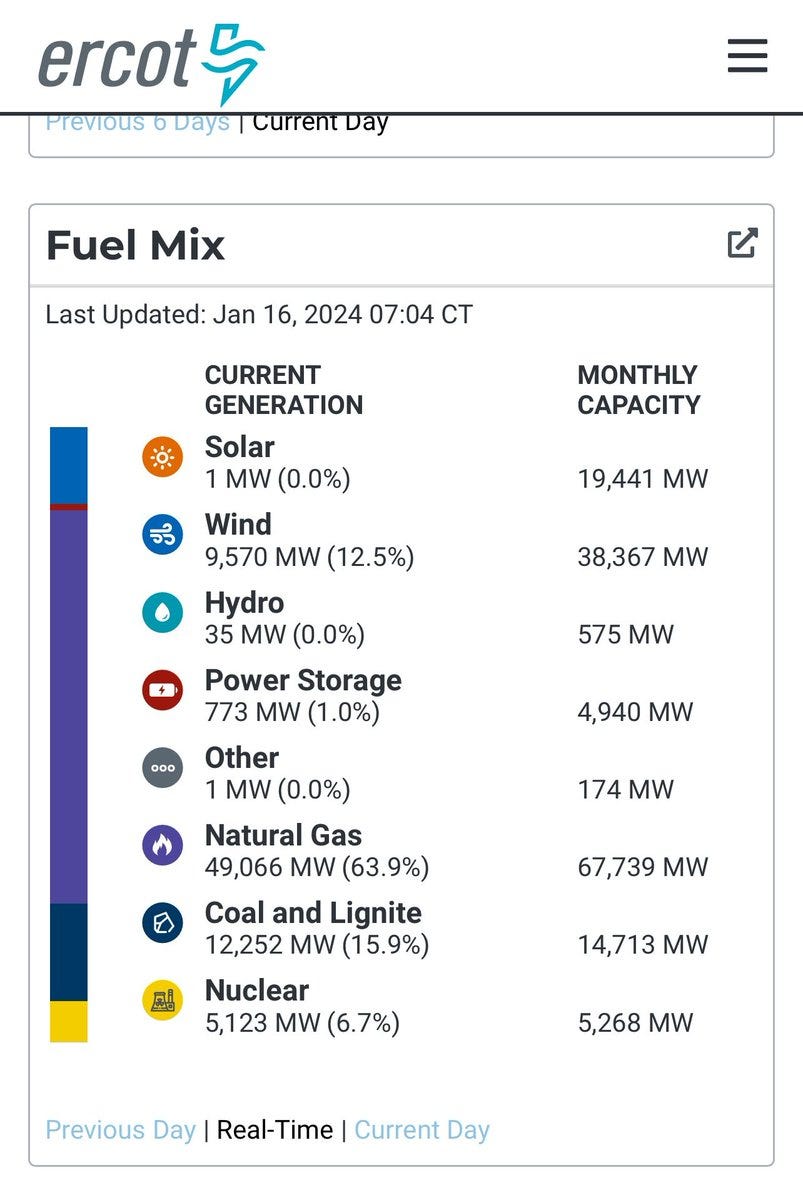- My Forums
- Tiger Rant
- LSU Recruiting
- SEC Rant
- Saints Talk
- Pelicans Talk
- More Sports Board
- Fantasy Sports
- Golf Board
- Soccer Board
- O-T Lounge
- Tech Board
- Home/Garden Board
- Outdoor Board
- Health/Fitness Board
- Movie/TV Board
- Book Board
- Music Board
- Political Talk
- Money Talk
- Fark Board
- Gaming Board
- Travel Board
- Food/Drink Board
- Ticket Exchange
- TD Help Board
Customize My Forums- View All Forums
- Show Left Links
- Topic Sort Options
- Trending Topics
- Recent Topics
- Active Topics
Started By
Message
re: Wind Power Production Drops Despite 6.2GW of Added Capacity
Posted on 5/1/24 at 5:52 pm to SaintEB
Posted on 5/1/24 at 5:52 pm to SaintEB
not sure what else there is to explain. The power grid is not rated high enough, storage isn’t more widespread, substations are undersized to handle the demand, etc.
Think about rolling blackouts. They perform these when the systems are stressed to the max due to demand, weather, combination of both at times, EVEN WITH renewables entering the grid.
If utilities had substations sized more capably, more modern transmission lines with less losses, more integrated storage systems, they could take in more generation and distribute, causing less stress on the systems, removing the need for a rolling blackout.
Think about rolling blackouts. They perform these when the systems are stressed to the max due to demand, weather, combination of both at times, EVEN WITH renewables entering the grid.
If utilities had substations sized more capably, more modern transmission lines with less losses, more integrated storage systems, they could take in more generation and distribute, causing less stress on the systems, removing the need for a rolling blackout.
Posted on 5/1/24 at 5:59 pm to PikesPeak
quote:
If utilities had substations sized more capably, more modern transmission lines with less losses, more integrated storage systems, they could take in more generation and distribute, causing less stress on the systems, removing the need for a rolling blackout.
This is basically what VPP is trying to accomplish.
Posted on 5/1/24 at 9:38 pm to PikesPeak
quote:
I wouldn't go that far.
If that graph took into account the massive wind and solar tax incentives and subsidies it would look very different. Just from a basic understanding of power it also doesn't make sense - every wind and solar project must be backed by baseload since it does not maintain a capacity near nameplate. To translate that, every solar and wind installation needs reserve capacity and that is usually picked up by redundant natural gas generation.

quote:
The power grid is not rated high enough, storage isn’t more widespread, substations are undersized to handle the demand, etc.
Utility storage batteries will not be the saving grace by any means unless some breakthrough happens. With the capacities that exist now, we are talking minutes or hours more of backup power for costs of billions of dollars. So if we double utility battery storage our capacity goes from 2 hours to 4 hours? That won't even make a dent in what is required on the grid and will cost billions. And when weather gets bad, you'll see a lot of nothing from it. Here is the energy mix in Texas during a cold front back in February.

And I wouldn't consider alternatives to be very weather resilient either.

quote:
If utilities had substations sized more capably, more modern transmission lines with less losses, more integrated storage systems, they could take in more generation and distribute, causing less stress on the systems, removing the need for a rolling blackout.
This I will certainly agree with. A lot of the transformers and substations are starting to get near the end of their service life in areas. And we are looking at lead times of multiple years for large power transformers. Even pole mount single phase transformers are out almost a year right now. This is going to become a problem regardless of how much the US ramps up its own production. Grain-oriented steel is primarily made in China and is critical for building transformer cores.
But again, we come back full circle to the original topic for new generation. Invest money where you get the most energy density and biggest return on energy investment. Unfortunately we are not going that direction and we will continue to have problems similar to Germany. California will be first.

Posted on 5/2/24 at 6:10 pm to PikesPeak
quote:
Think about rolling blackouts. They perform these when the systems are stressed to the max due to demand, weather, combination of both at times, EVEN WITH renewables entering the grid.
Most times, rolling blackouts have more to do with N-1 scenarios in combination with demand/weather. The country is separated in to 3 large "grids" (eastern interconnect, western interconnect, and Texas interconnect, yes they have their own) each with their own set of issues. But even deeper than that, each territory is separated by independent system operators (9 total that actually go into Canada) that study scenarios in real-time and future, for planned outages. If they see a problem, or potential problem, the line is not take down.
quote:
If utilities had substations sized more capably, more modern transmission lines with less losses, more integrated storage systems, they could take in more generation and distribute, causing less stress on the systems, removing the need for a rolling blackout.
Transmission lines are what carry voltage to substation transformers. They don't "take in generation". They serve load. I'm curious as to what you think a "modern transmission line" is. There isn't a technology that magically makes transmission lines have less losses. Its about wire size and distance. That's it. The bigger the wire, the higher the amperage capacity it can take and the further it can carry voltage without substantial loss.. However, the higher the voltage, the lower the amperage that is carried. Thus the need for transmission.
I'm not sure how integrated storage systems help in a potential blackout situation so I'm open to hearing your thoughts on that.
quote:
EVEN WITH renewables entering the grid.
Think about this for a minute. We have load capacity. We put more with renewables, unless they are taking units offline in conjunction with the renewables coming online. Why would that cause rolling blackouts? It doesn't. The only time I've ever been asked to shed load in a blackout situation was because there was a transmission line loss (N-1), and the capacity that the down line would usually take, has to pass on other lines, thus putting them at risk of overload. I have never shed load due to a substation transformer's limitations, a distribution line's limitations, or even a sub-transmission line's (34.5 kv - 69 kv) limitation.
Utility infrastructure as a whole is a completely different topic. The aging infrastructure doesn't necessarily translate to lower capacity. I'm more concerned about hardware availability, distribution transformer lead times, power transformer lead times (a typical 20MVA used to be 20-24 week and are now at 2-3 years), and pole availability as nothing comes within a reasonable time anymore. This puts a strain on restoration efforts. So, every utility over orders which exasperates the problem even further with no end in sight. So, even if we wanted to upgrade infrastructure, we don't have the supply chain to support it. Even then, it wouldn't guarantee that a rolling blackout wouldn't happen.
Popular
Back to top

 3
3








